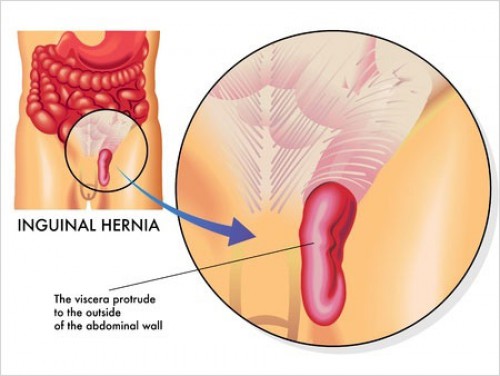A Hernia occurs when the contents of a body cavity protrude out of the membrane in which they are normally contained through a weak spot in a surrounding muscle or connective tissue. Hernias by themselves may or may not produce symptoms as they are asymptomatic and can cause slight to severe pain. A hernia does not get better with time, nor will it go away by itself (except very small congenital navel hernia). It is seen that men are more prone to inguinal hernias than women because of basic differences in anatomy. The area where hernias occur most often has a very different function in men than in women. However, there is no guaranteed way to prevent getting a hernia or to prevent recurrence of a hernia. Surgery is the only way to cure a hernia as it cannot go away on its own. Now days, many types of surgical hernia repairs are available at a hernia treatment hospital in India.
WHAT IS HERNIA ?
A hernia is a weakness or tear in the abdominal muscles that allows fatty tissue or an organ such as the intestines to protrude through the weak area. Hernias can occur in many places in the body, most often in the groin. Sometimes, a weak spot in the abdominal wall can even be present at birth.
Types of Hernia : -
According to a hernia specialist doctor, there are four types of hernia, which are as follow-
1. Inguinal Hernias - :
Inguinal hernias are the most common types of male hernias, that are located in the lower abdomen and thigh, move towards the scrotum, as a bulge in the groin. They are more common in men than women. Inguinal hernias usually occur when fatty tissue or part of a bowel, bulge out through a part of the lower abdominal wall known as inguinal canal.
There are two types of inguinal hernias:
Direct inguinal hernia: They occur as a result of weakness in the floor of the inguinal canal. They are usually bilateral and seen in elderly with chronic conditions which increase intra abdominal pressure such as chronic cough, chronic constipation etc.
Indirect inguinal hernias: They occur when the inguinal canal fails to close before birth. The hernia may appear in a male’s scrotum or in the fold of skin at the opening of a female’s vagina. This is the most common type of inguinal hernia. And it may occur at birth or later in life. Indirect hernias are more common in males.
2.Femoral Hernia
Femoral hernias also occur in the groin region just below the groin crease anad more common in women than men. They occur due to a weakness in the lower groin region usually as a result of pregnancy and child. These hernias are more prone to complications and hence should be repaired once they are diagnosed.
3.Umbilical Hernia
An umbilical hernia occurs when part of the intestine protrudes through the umbilical opening in the abdominal muscles. These hernias may occur in infants at or just after birth and may resolve by three or four years of age. However, the area of weakness can persist throughout life and can occur in men, women, and children at any time. In adults, umbilical hernias will not resolve and may progressively worsen over time. They are sometimes caused by abdominal pressure or due to overweight, excessive coughing, or pregnancy.
4.Ventral Hernia
Ventral hernia is a hernia that surfaces on any part of the ventral surface of the human body. It results in a bulge or tear in the ventral surface that develops like a ballon-like sac.
There are three common types of ventral hernias.
An Incisional Hernia is a hernia that occurs through a previously made incision in the abdominal wall, i.e. the scar left from a previous surgical operation.
A Periumbilical hernia occurs around the belly button.
An Epigastric hernia occurs above the belly button.


